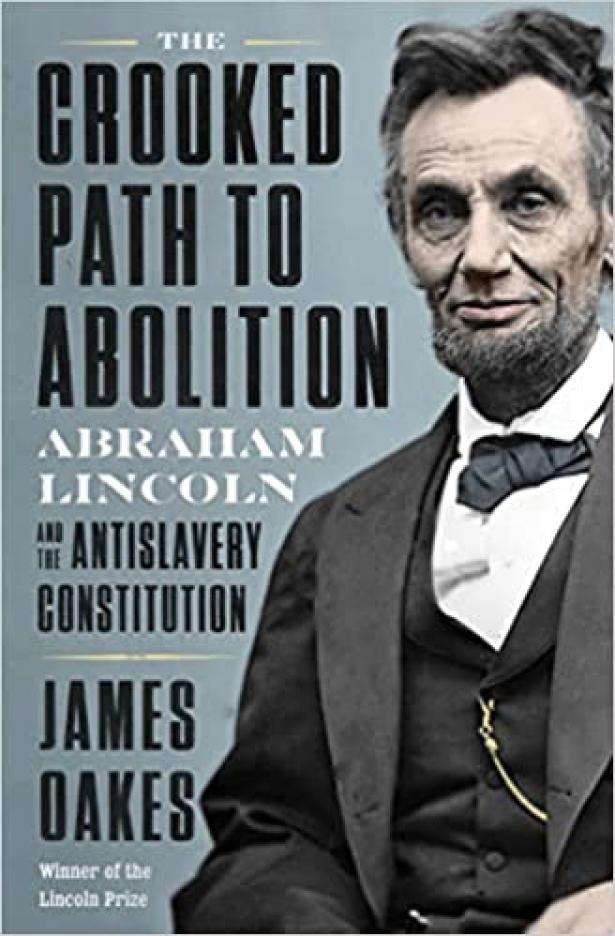The Crooked Path to Abolition: Abraham Lincoln and the Antislavery Constitution
James Oakes
W. W. Norton & Company
ISBN-13: 978-1324005858
Abraham Lincoln and slavery is a complex subject. Renowned scholar of the “peculiar institution” of enslaving African American people, James Oakes writes in The Crooked Path to Abolition, that in modern scholarship “Lincoln was either the Great Emancipator” or a “reluctant emancipator . . . held in check by his inability to imagine that Black people, once free, could live as equals among white Americans.”
“Lincoln thought a great deal about slavery as a moral, political, and social issue, but thought very little about race.” He registered no “opposition against state laws discriminating against Blacks.” The later 14th president “never endorsed outright opposition to the Fugitive Slave Act and never denounced it as unconstitutional.” He was “repelled” by “the stridency of so much abolitionist rhetoric.”
“Lincoln always hated slavery, he once said, as much as any abolitionist,” but he did nothing to support emancipation. He saw an egalitarian white “free labor system” as the source of northern prosperity but he held no such regard for Black free labor.
Oakes uses the term “Antislavery Project” for an informal “series of specific policies that were designed to stop and then reverse the expansion of slavery” that Lincoln and others followed. They wanted to keep enslavement out of newly created states to protect free white labor and to “pressure the older slave states” “to abolish slavery on their own,” “the most peaceful, most gradual abolition taking a century to complete.”
In addition to personal and political conflicted attitudes on this greatest issue of his time, Lincoln lived then, as Americans do now, in an age of constitutionalism “where every major issue was debated in constitutional terms,” including as a means of protecting what defied common sense and/or morally indefensible positions. Other people used the Constitution as an excuse for what they did not do.
The United States began with officially ignoring the issue of slavery in 1776. Eleven years later, the “byzantine or indecipherable” process that created the Constitution created a documented that tilted “in both proslavery and antislavery directions,” reflecting the America of that time.
With enslavement, as with the Civil War, Americans on all sides claimed to fight for the original intent of the Constitution. As with today, finding the path to where the nation needed to be did not seem inevitable. Getting there with regard to emancipation and race proved a divisive, long, tortuous, and ugly process.
“However, constitutional restraint did not mean constitutional impotence.” Today, Americans celebrate the persons who persevered and won emancipation including Abraham Lincoln. The Crooked Path to Abolition provides “a comprehensive history of the antislavery Constitution to which Lincoln was devoted.”
Oakes explains the details of the Constitution that fueled this debate and their subsequent history of how “abolitionists and antislavery politicians were colonizing the Constitution.” Much of this narrative the reader will recognize, such as the Missouri Compromise, and the Compromise of 1850, the Dred Scott decision, the Fugitive Slave Act, and the readmission of the seceding states.
Other facts, such as the Constitutional debate on ending enslavement in the District of Columbia and how the “Fugitive Slave Act of 1850 provoked an unprecedented wave of militancy among northern Blacks” are not so well known. In other works, too often the Black contribution to the abolitionist effort consists of hardly more than biographical notes on a few famous individuals.
The Confederate States of America copied into its own constitution what of the United States’ document that arguably endorsed Black people as property. By contrast, other Americans, including Lincoln, pointed out that the Constitution gave certain fundamental rights to Black people in bondages by referring to them as persons, not as possessions.
“Both versions of Lincoln assume he had had enormous powers that he simply did not have.” Lincoln did his part, but critics can also see him as only serving a role in a greater process. Over many years, Lincoln obtained a tremendous education in race related citizenship, emancipation, labor, race, and related issues that served him well during the American Civil War.
James Oakes in The Crooked Path to Abolition tells how far Lincoln could go on emancipation within the Constitution—but how far was he willing to go? This well-written text, in a relatively small number of pages, covers its subject well as an education in the complexities of American Constitutional politics from which much remains relevant to the present. This work includes annotation.
Robert S. Davis is an award-winning senior professor of genealogy, geography, and history. His writing credits include more than 1,000 contributions as books, articles, and reviews in historical, library, education, and archival journals related to the South. He is also a frequent speaker.


Spread the word